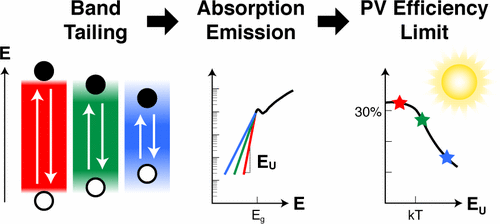当前位置:
X-MOL 学术
›
ACS Energy Lett.
›
论文详情
Our official English website, www.x-mol.net, welcomes your
feedback! (Note: you will need to create a separate account there.)
Radiative Efficiency Limit with Band Tailing Exceeds 30% for Quantum Dot Solar Cells
ACS Energy Letters ( IF 19.3 ) Pub Date : 2017-10-25 00:00:00 , DOI: 10.1021/acsenergylett.7b00923 Joel Jean 1 , Thomas S. Mahony 1 , Deniz Bozyigit 1 , Melany Sponseller 1 , Jakub Holovský 2, 3 , Moungi G. Bawendi 4 , Vladimir Bulović 1
ACS Energy Letters ( IF 19.3 ) Pub Date : 2017-10-25 00:00:00 , DOI: 10.1021/acsenergylett.7b00923 Joel Jean 1 , Thomas S. Mahony 1 , Deniz Bozyigit 1 , Melany Sponseller 1 , Jakub Holovský 2, 3 , Moungi G. Bawendi 4 , Vladimir Bulović 1
Affiliation

|
Thin films of colloidal quantum dots (QDs) are promising solar photovoltaic (PV) absorbers in spite of their disordered nature. Disordered PV materials face a power conversion efficiency limit lower than the ideal Shockley–Queisser bound because of increased radiative recombination through band-tail states. However, investigations of band tailing in QD solar cells have been largely restricted to indirect measurements, leaving their ultimate efficiency in question. Here we use photothermal deflection spectroscopy (PDS) to robustly characterize the absorption edge of lead sulfide (PbS) QD films for different bandgaps, ligands, and processing conditions used in leading devices. We also present a comprehensive overview of band tailing in many commercial and emerging PV technologies—including c-Si, GaAs, a-Si:H, CdTe, CIGS, and perovskites—then calculate detailed-balance efficiency limits incorporating Urbach band tailing for each technology. Our PDS measurements on PbS QDs show sharp exponential band tails, with Urbach energies of 22 ± 1 meV for iodide-treated films and 24 ± 1 meV for ethanedithiol-treated films, comparable to those of polycrystalline CdTe and CIGS films. From these results, we calculate a maximum efficiency of 31%, close to the ideal limit without band tailing. This finding suggests that disorder does not constrain the long-term potential of QD solar cells.
中文翻译:

量子点太阳能电池带尾的辐射效率极限超过30%
胶体量子点(QDs)薄膜尽管有无序的性质,但仍有望成为太阳能光伏(PV)吸收剂。由于通过带尾态的辐射复合增加,无序的光伏材料面临的功率转换效率极限低于理想的Shockley-Queisser极限。然而,对量子点太阳能电池中的带拖尾的研究在很大程度上仅限于间接测量,这使它们的最终效率成为问题。在这里,我们使用光热偏转光谱(PDS)来针对领先设备中使用的不同带隙,配体和加工条件,稳健地表征硫化铅(PbS)QD薄膜的吸收边缘。我们还将全面介绍许多商用和新兴PV技术中的带拖尾,包括c-Si,GaAs,a-Si:H,CdTe,CIGS,和钙钛矿-然后结合每种技术的Urbach带拖尾来计算详细的平衡效率极限。我们在PbS量子点上进行的PDS测量显示出尖锐的指数带尾,与多晶CdTe和CIGS膜相比,碘化物处理的膜的Urbach能量为22±1 meV,乙二硫醇处理的膜的Urbach能量为24±1 meV。根据这些结果,我们计算出最大效率为31%,接近没有带拖尾的理想极限。这一发现表明,无序不限制QD太阳能电池的长期潜力。可与多晶CdTe和CIGS薄膜相媲美。根据这些结果,我们计算出最大效率为31%,接近没有带拖尾的理想极限。这一发现表明,无序不限制QD太阳能电池的长期潜力。可与多晶CdTe和CIGS薄膜相媲美。根据这些结果,我们计算出最大效率为31%,接近没有带拖尾的理想极限。这一发现表明,无序不限制QD太阳能电池的长期潜力。
更新日期:2017-10-25
中文翻译:

量子点太阳能电池带尾的辐射效率极限超过30%
胶体量子点(QDs)薄膜尽管有无序的性质,但仍有望成为太阳能光伏(PV)吸收剂。由于通过带尾态的辐射复合增加,无序的光伏材料面临的功率转换效率极限低于理想的Shockley-Queisser极限。然而,对量子点太阳能电池中的带拖尾的研究在很大程度上仅限于间接测量,这使它们的最终效率成为问题。在这里,我们使用光热偏转光谱(PDS)来针对领先设备中使用的不同带隙,配体和加工条件,稳健地表征硫化铅(PbS)QD薄膜的吸收边缘。我们还将全面介绍许多商用和新兴PV技术中的带拖尾,包括c-Si,GaAs,a-Si:H,CdTe,CIGS,和钙钛矿-然后结合每种技术的Urbach带拖尾来计算详细的平衡效率极限。我们在PbS量子点上进行的PDS测量显示出尖锐的指数带尾,与多晶CdTe和CIGS膜相比,碘化物处理的膜的Urbach能量为22±1 meV,乙二硫醇处理的膜的Urbach能量为24±1 meV。根据这些结果,我们计算出最大效率为31%,接近没有带拖尾的理想极限。这一发现表明,无序不限制QD太阳能电池的长期潜力。可与多晶CdTe和CIGS薄膜相媲美。根据这些结果,我们计算出最大效率为31%,接近没有带拖尾的理想极限。这一发现表明,无序不限制QD太阳能电池的长期潜力。可与多晶CdTe和CIGS薄膜相媲美。根据这些结果,我们计算出最大效率为31%,接近没有带拖尾的理想极限。这一发现表明,无序不限制QD太阳能电池的长期潜力。











































 京公网安备 11010802027423号
京公网安备 11010802027423号